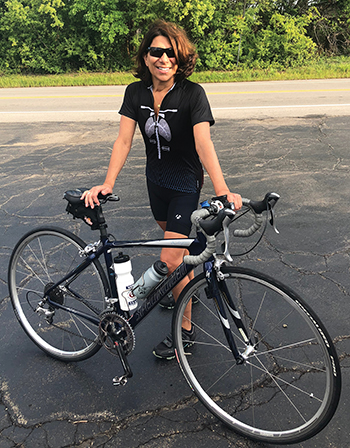Lung Cancer Survivor
Together We Are Stronger

Terri Ann DiJulio had a history with tobacco but no family history of lung cancer when she received her early-stage diagnosis in 2005. But after her mother was also diagnosed, doctors advised regular screenings for close relatives. Nearly 15 years later, Terri Ann is among five family members to be diagnosed and has become a passionate advocate and tireless fundraiser for lung cancer awareness.
I’ll never forget the conversation with my surgical oncologist. “You’re only 44 years old,” he told me. “Chances of this being malignant are 10 percent at most.” Then I woke up after surgery without the lower lobe of my right lung. At the time, I didn’t realize how unbelievably lucky I was that the tumor was early-stage and could be treated by surgery alone.
My good fortune became more evident 18 months later when my mother – who’d never picked up a cigarette in her life – was diagnosed with Stage III lung cancer. For the next few years, I watched her go through chemotherapy, surgery to remove lymph nodes, full chest and brain radiation and targeted drug therapy. I traveled from Wisconsin to Pennsylvania to help my sister care for her, thinking I’d go back and forth. But my mom steadily got worse, so I stayed, moving nearby. We had no idea her health would decline so fast or that it would be the last six months of her life.
We fell into a routine. While my sister got my mom up and ready for the caregiver to come, I’d drive my niece to school before my sister went to work. I’d pick up my niece after school, bring her home and start dinner. When my sister came home, we’d all eat, and then she and I would get my mom settled and ready for bed. I’d go home and my sister would help my niece with whatever she needed and send her off to bed. Then we’d do it all over again the next day.
As a cancer caregiver, I think you really have to develop the mindset that your own life goes on hold. But I have no regrets, not one. Those months with my mother were a gift for which I’ll always be grateful. She was 79.
With my mom’s diagnosis so closely following mine, the doctors recommended that our close family members get regular lung cancer screenings with low-dose computed tomography. Mom’s brother was diagnosed and fought the disease for 11 years prior to his death. And an uncle by marriage on the other side of the family, who never smoked, also died from the disease. My mom’s sister is now Stage IV. Biomarker testing indicated the KRAS gene mutation in her tumor cells, so she’s in a clinical trial studying a drug targeted to that and has already seen a reduction in tumor size.
In the midst of all of this, I had a recurrence 12 years after my first diagnosis. The kindest, most compassionate pulmonologist on the face of the earth broke it to me gently. I was devastated. The tumor was 8 millimeters, smaller than the size of a pea. This time, the doctor recommended stereotactic body radiation therapy — SBRT. It very precisely delivered intense doses of radiation so there was less damage to surrounding tissue. And it worked. SBRT hadn’t been available back when I was first diagnosed, nor was it available when my mom was diagnosed. I was really struck by the treatment advances that had been made over the years.
An avid cyclist, I participated in a fundraising ride from Philadelphia to the Atlantic shore after my first surgery in 2005. I used training for this ride as rehab for my lungs. I started out slow, just walking until I gradually felt strong enough to get on the bike again to continue training. I turned that ride into a very successful cancer fundraiser.
After my second diagnosis and watching so many people I love suffer from lung cancer, I thought about how my voice and my family’s story could help improve outcomes for others. Advances have been made, but more needs to be done to make sure my family’s next generation, including my niece, will have more and better treatment options.
I am now very involved with GO2 Foundation for Lung Cancer. I’ve raised more than $50,000 for research and patient care through cycling and the generosity of family and friends. I’ve also had the privilege of speaking twice on Capitol Hill to help impact legislation and federal funding for research. Having been both a lung cancer patient and a lung cancer caregiver, I’ve witnessed firsthand just how stigmatized and underfunded this disease is. The truth is, if you have lungs, you can get lung cancer.
I really encourage survivors to consider getting involved in lung cancer advocacy. The lung cancer community needs all of us, and you can find great comfort there as well. We have a much louder voice when we band together and show our diversity in age, gender, race and ethnicity. Together we are stronger.


